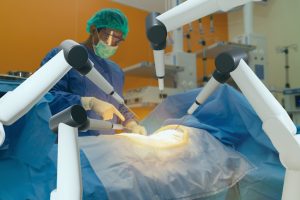In recent years, technological advancements in surgery have made procedures more precise, minimally invasive, and safer for patients. One such advancement is robotic-assisted gynaecologic surgery. This innovative surgical technique is revolutionizing the way gynaecologic procedures are performed, offering patients a quicker recovery time, less pain, and improved outcomes. Dr. Shweta Mendiratta, one of the best robotic surgeons in Faridabad, is at the forefront of this technique, providing women with the latest in medical care for various gynaecological conditions.
What Is Robotic-Assisted Gynaecologic Surgery?
Robotic-assisted gynaecologic surgery refers to the use of a robotic system to assist surgeons in performing minimally invasive surgeries. Unlike traditional open surgery, where large incisions are made, robotic surgery is performed through small incisions, reducing trauma to the body. The surgeon operates the robot with a console that provides a highly magnified, 3D view of the surgical site, allowing for greater precision and control.
The robotic system, typically the da Vinci Surgical System, consists of robotic arms, a camera, and specialized instruments. The arms are controlled by the surgeon from a console, and the instruments can rotate and move with greater flexibility than human hands, making it possible to perform delicate procedures in hard-to-reach areas with unmatched accuracy.
How Does Robotic Surgery Work?
- Small Incisions
Robotic surgery involves making tiny incisions in the body. These incisions are usually less than an inch in size, through which the robotic arms, camera, and surgical instruments are inserted. The smaller incisions result in reduced scarring and less trauma to the tissues, promoting faster healing. - Enhanced Visualization
One of the significant advantages of robotic surgery is the enhanced visualization it provides. The robotic system’s camera offers a 3D, high-definition view of the surgical area, allowing the surgeon to see intricate details and operate with greater accuracy. This is especially beneficial in complex gynaecological procedures, where precision is critical. - Precision and Control
The robotic arms have exceptional range of motion and can rotate 360 degrees, allowing the surgeon to perform delicate tasks with unmatched precision. The instruments also have enhanced dexterity, mimicking the human wrist’s movements, which provides better control during the surgery. - Minimally Invasive
Because robotic surgery is minimally invasive, it causes less damage to surrounding tissues, reduces the risk of infection, and minimizes post-operative pain. As a result, patients typically experience shorter hospital stays, quicker recoveries, and faster return to normal activities. - Surgeon’s Console
The surgeon operates the robotic system from a console, where they can control the robotic arms and view the surgical site in high-definition 3D. The surgeon’s hand movements are translated into precise movements by the robotic system, enhancing the precision of the surgery.
Benefits of Robotic-Assisted Gynaecologic Surgery
- Reduced Recovery Time
Robotic surgery is less invasive than traditional methods, leading to smaller incisions and reduced recovery time. Most patients can return to their normal activities much faster, with many being able to go home the same day or the following day. - Less Pain and Discomfort
Smaller incisions mean less pain and discomfort post-surgery. Many patients report requiring less pain medication compared to traditional surgery. - Minimal Scarring
The small incisions used in robotic surgery result in minimal scarring, providing patients with a cosmetic advantage, especially when performing surgeries on areas like the abdomen. - Greater Precision and Accuracy
The 3D visualization and enhanced dexterity offered by robotic surgery give the surgeon greater precision. This can be particularly beneficial for complex gynaecologic procedures, such as hysterectomy, myomectomy (removal of fibroids), or pelvic organ prolapse surgery. - Lower Risk of Complications
The precision of robotic surgery reduces the risk of complications, such as bleeding, infection, and damage to surrounding organs. The minimally invasive nature of the procedure also means a lower likelihood of blood loss and a faster healing process.
Conditions Treated with Robotic-Assisted Gynaecologic Surgery
Robotic-assisted surgery can be used to treat a wide range of gynaecological conditions, including:
- Hysterectomy (removal of the uterus)
- Myomectomy (removal of fibroids)
- Endometriosis surgery
- Ovarian cysts or tumors
- Pelvic organ prolapse
- Fertility preservation procedures
Conclusion
Robotic-assisted gynaecologic surgery is an advanced, minimally invasive approach that offers significant advantages in terms of precision, recovery time, and patient comfort. If you’re considering gynaecological surgery, it’s important to consult with an experienced robotic surgeon who can determine the best treatment plan tailored to your needs.
Dr. Shweta Mendiratta, one of the best robotic surgeons in Faridabad, is committed to providing state-of-the-art care and ensuring the best possible outcomes for her patients. With expertise in robotic-assisted gynaecological procedures, she helps women navigate complex surgeries with minimal discomfort and a quick recovery.
If you are facing a gynaecological condition that may require surgery, consult Dr. Shweta Mendiratta today to explore the benefits of robotic-assisted surgery and take the first step toward a healthier, more comfortable life.





